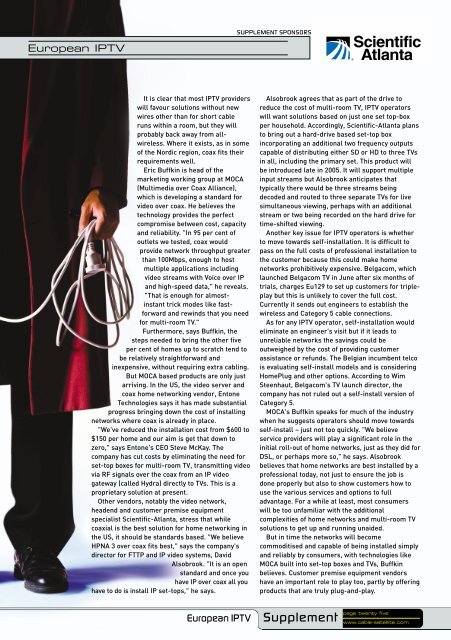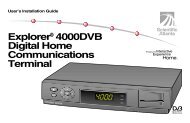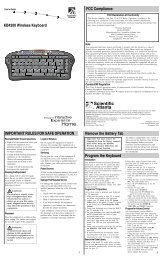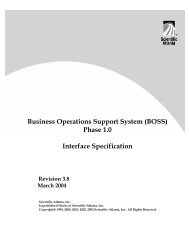European IPTV - Scientific Atlanta
European IPTV - Scientific Atlanta
European IPTV - Scientific Atlanta
Create successful ePaper yourself
Turn your PDF publications into a flip-book with our unique Google optimized e-Paper software.
SUPPLEMENT SPONSORS<strong>European</strong> <strong>IPTV</strong>It is clear that most <strong>IPTV</strong> providerswill favour solutions without newwires other than for short cableruns within a room, but they willprobably back away from allwireless.Where it exists, as in someof the Nordic region, coax fits theirrequirements well.Eric Buffkin is head of themarketing working group at MOCA(Multimedia over Coax Alliance),which is developing a standard forvideo over coax. He believes thetechnology provides the perfectcompromise between cost, capacityand reliability. "In 95 per cent ofoutlets we tested, coax wouldprovide network throughput greaterthan 100Mbps, enough to hostmultiple applications includingvideo streams with Voice over IPand high-speed data," he reveals."That is enough for almostinstanttrick modes like fastforwardand rewinds that you needfor multi-room TV."Furthermore, says Buffkin, thesteps needed to bring the other fiveper cent of homes up to scratch tend tobe relatively straightforward andinexpensive, without requiring extra cabling.But MOCA based products are only justarriving. In the US, the video server andcoax home networking vendor, EntoneTechnologies says it has made substantialprogress bringing down the cost of installingnetworks where coax is already in place."We've reduced the installation cost from $600 to$150 per home and our aim is get that down tozero," says Entone's CEO Steve McKay. Thecompany has cut costs by eliminating the need forset-top boxes for multi-room TV, transmitting videovia RF signals over the coax from an IP videogateway (called Hydra) directly to TVs. This is aproprietary solution at present.Other vendors, notably the video network,headend and customer premise equipmentspecialist <strong>Scientific</strong>-<strong>Atlanta</strong>, stress that whilecoaxial is the best solution for home networking inthe US, it should be standards based. "We believeHPNA 3 over coax fits best," says the company'sdirector for FTTP and IP video systems, DavidAlsobrook. "It is an openstandard and once youhave IP over coax all youhave to do is install IP set-tops," he says.Alsobrook agrees that as part of the drive toreduce the cost of multi-room TV, <strong>IPTV</strong> operatorswill want solutions based on just one set top-boxper household. Accordingly, <strong>Scientific</strong>-<strong>Atlanta</strong> plansto bring out a hard-drive based set-top boxincorporating an additional two frequency outputscapable of distributing either SD or HD to three TVsin all, including the primary set. This product willbe introduced late in 2005. It will support multipleinput streams but Alsobrook anticipates thattypically there would be three streams beingdecoded and routed to three separate TVs for livesimultaneous viewing, perhaps with an additionalstream or two being recorded on the hard drive fortime-shifted viewing.Another key issue for <strong>IPTV</strong> operators is whetherto move towards self-installation. It is difficult topass on the full costs of professional installation tothe customer because this could make homenetworks prohibitively expensive. Belgacom, whichlaunched Belgacom TV in June after six months oftrials, charges Eu129 to set up customers for tripleplaybut this is unlikely to cover the full cost.Currently it sends out engineers to establish thewireless and Category 5 cable connections.As for any <strong>IPTV</strong> operator, self-installation wouldeliminate an engineer's visit but if it leads tounreliable networks the savings could beoutweighed by the cost of providing customerassistance or refunds. The Belgian incumbent telcois evaluating self-install models and is consideringHomePlug and other options. According to WimSteenhaut, Belgacom's TV launch director, thecompany has not ruled out a self-install version ofCategory 5.MOCA's Buffkin speaks for much of the industrywhen he suggests operators should move towardsself-install – just not too quickly. "We believeservice providers will play a significant role in theinitial roll-out of home networks, just as they did forDSL, or perhaps more so," he says. Alsobrookbelieves that home networks are best installed by aprofessional today, not just to ensure the job isdone properly but also to show customers how touse the various services and options to fulladvantage. For a while at least, most consumerswill be too unfamiliar with the additionalcomplexities of home networks and multi-room TVsolutions to get up and running unaided.But in time the networks will becomecommoditised and capable of being installed simplyand reliably by consumers, with technologies likeMOCA built into set-top boxes and TVs, Buffkinbelieves. Customer premise equipment vendorshave an important role to play too, partly by offeringproducts that are truly plug-and-play.<strong>European</strong> <strong>IPTV</strong>Supplementpage twenty fivewww.cable-satellite.com















